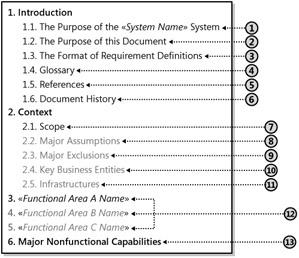Chapter 2: Synopsis of
Overview
This chapter discusses what a requirements specification should contain. As with Chapter 1, it is a synopsis of a full version of the chapter that can be downloaded from the book's associated Web page at http://www.microsoft.com/mspress/companion/9780735623989. (See the Preface for more information.) The synopsis is a flying overview. The full version goes into considerably more detail and is intended primarily as a reference, to call upon when you want advice on what to put into a particular section and why. Both versions are structured in a similar manner to the kind of requirements specification that this chapter presents.
There's no single right way to organize a requirements specification, but certain topics recur in most systems and deserve their own sections. Figure 2-1 shows a suggested structure for a requirements specification, in the form of a table of contents that identifies thirteen key topics described in this chapter.

Figure 2-1: Suggested structure of a requirements specification, with thirteen kinds of sections
The sections with grayed-out names are optional; include them as appropriate. In practice, all the top-level sections (except those in the "Introduction" and perhaps the "Context" section) will have extra subsections; some are likely to have many. This structure has worked well in practice, is clean and straightforward, and every section is present for a good reason. But no way of organizing a requirements specification is perfect for all occasions, so feel free to adjust it. Treat the thirteen key topics as parts that you can assemble in whatever way suits you: leave out parts that your system doesn't need, and merge parts together if each one is too small to justify its own section.
There are four types of top-level sections, which mirror the four top-level sections that follow in this chapter: "Introduction," "Context," functional areas (which do the hard work of specifying what the system must actually do and where the bulk of the requirements reside), and "Major Nonfunctional Capabilities."
EAN: 2147483647
Pages: 110